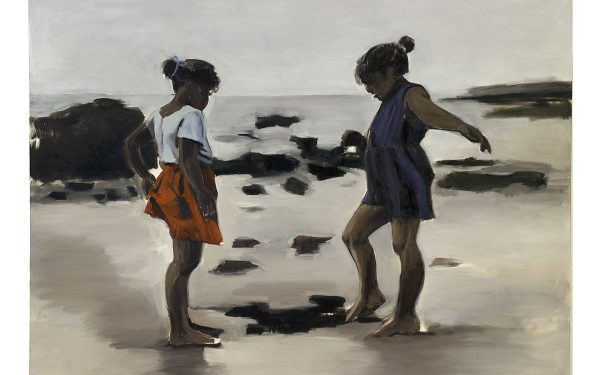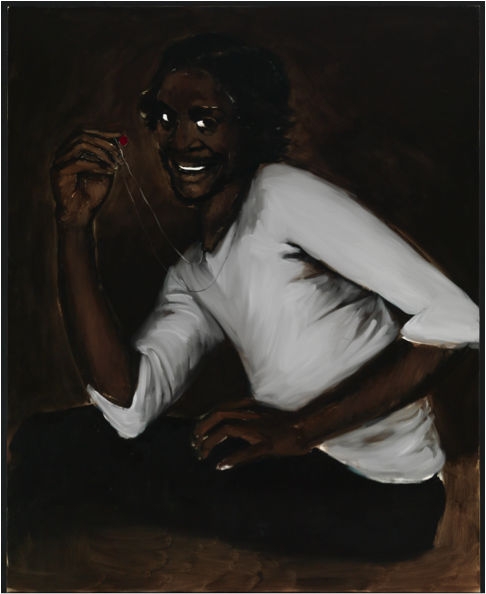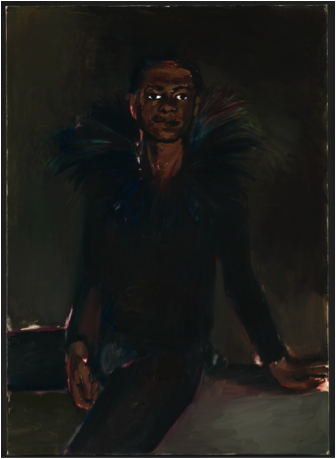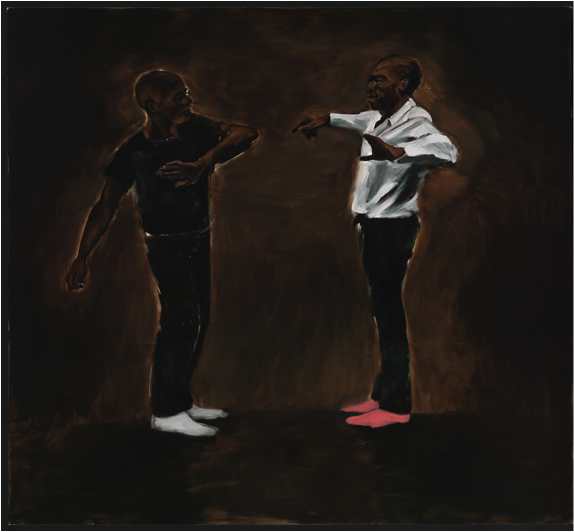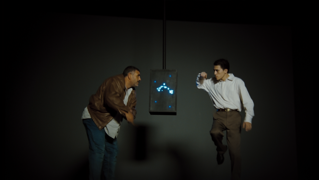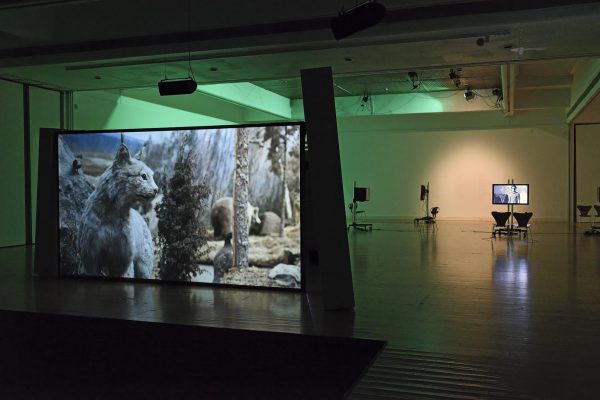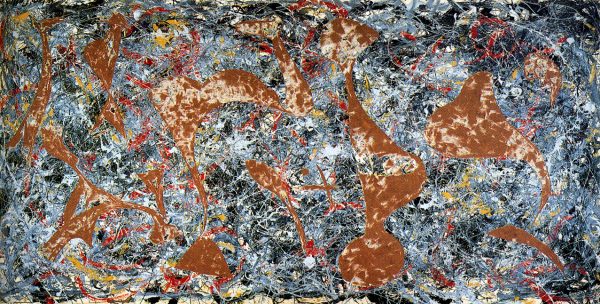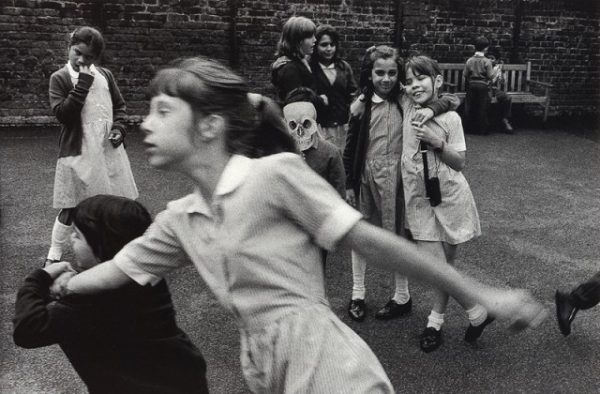*
A person is represented, sitting in what appears to be the banal and conventional pose of a high street studio portrait photographer: a torso, half-twisted towards you, a hand is placed on a leg, another holds up to the face a pendant, dangling on a long, thin chain which dips down and reaches up around the neck.
The person’s head and face are covered in brushstrokes which appear as crude as those which describe the dark space behind, a failure to discriminate between the subject and background which feels like an aggression against the person. The face is so dis-affected that the author of this subject seems disinterested – almost uncannily so – in representing the body as human. The eyes are intense dashes of white, as are the teeth, bared in a smile, and the paint here, applied with more care, is thick, cartoonish. This smiling face appears charged with some satirical intent by the invisible hand of the artist, whose biography the gallery hand-out has summarised for our reassurance. The subject is not given a name, nor is the viewer given any context for what, for want of a better word, I have described as satire. On closer attention to the painting, any cheerfulness coaxed out of the subject by the studio photographer (who is, after all, probably only doing his job) appears forced to the point of a violent ambivalence. The person’s left hand, resting on the left leg, is outlined by spaces of white canvas with an apparent lack of care, and the person seems to be digging the nails of their hand into their own leg, as if fighting to contain the desire to break out of the painting.
Lynette Yiadom-Boakye, the maker of these paintings, born in London in 1977, is among the first generation of artists to reach maturity in the twenty-first century. Her inclusion in The Ungovernables, the triennial exhibition at the New Museum in New York, suggests her eminence among producers of an art which, according to the curators, ‘pursues a radical change in the everyday, but promises an upheaval that is not necessarily controllable.’ In an interview with a-n magazine, the artist explains her original plans were ‘to be a writer and/or optician. I had to rule out the optics because science was a problem.’ The artist’s Ghanaian parentage means her work is often categorised as art from the African diaspora; her interview by Hans Ulrich Obrist for Kaleidoscope magazine (Summer, 2012) appears in an Africa-themed issue, where she is described as an ‘Afropolitan artist’. Asked about her connection to Ghana and Africa, she says the identifications exist through her parents: ‘Ghana is present as a way of thinking and a way of seeing, which has influenced me.’ This simple and enigmatic formula may be important, but this essay will not attempt to characterise a Ghanaian ‘way of thinking and way of seeing’, such as they exist for the artist, but will attempt to see their evidence within the paintings. Yiadom-Boakye, who did not become an optician, is instead working at the foundations of optical science, addressing the question of how one human body recognises, refuses, or is unable to recognise, another
The Painting of Tradition
It is difficult to describe exactly how these paintings so compel the gaze, or rather, how their difficulty achieves this; the question of history appears to be important. First, because these paintings are at war – which is to say, at home – with the history of the tradition of painting. Secondly, as the artist insists her subjects are not living models but composites of sketches and memories, ‘pulled out of the air somehow […] translating paint into people’ (interview with Jamie Stevens, Chisenhale Gallery website). These people are, moreover, ‘non-specific’, and the artist says she tries ‘not to root them to a particular time or place’. How then are we to read paintings like ‘Fiscal Sweatsuit’? The title alone seems simultaneously a provocation to, and (in its absurdity) defiance of, understanding the work according to politics and history. The apparent arbitrariness of pulling scenes and names ‘out of the air’ masks the real source of the paintings’ power.
These persons may not be fixed to a definite time or place, a set of fiscal conditions or particular sweatsuit, but they remain, however obscurely, in relation to social and political events. In their introduction to Contemporary African Art Since 1980 Okwui Enwezor and Chika Okeke-Agulu notice the dangers of viewing art from the African continent or diaspora as ‘post-historical’; but, if Yiadom-Boakye’s figures are detached from the world or even, as the artist puts it in the same interview, ‘superhuman’, how can their non-specificity be understood historically? The first resort for critics of this work, when confronting this double-bind, has been to fix the paintings in a genealogy of Western portraiture. The artist’s influence by Whistler, Sargent, Manet, Goya, Velazquez, Frans Hals have all been mentioned; some of these names the artist herself acknowledges publicly. It is a testament to the power of this work, however, that although these comparisons are not unjustified, the readings they produce are insufficient.
The singularity of this work doesn’t reside in any bland continuation of a style of portraiture, but a position taken in relation to this inheritance. Writing in the Nation last year, Barry Schwabsky heralded Yiadom-Boakye and Silke Otto-Knapp, the London-based German-born painter, as members of a new movement in art, influenced by John Currin, Karen Kilimnik, Robert Henri and William Nicholson. In my eyes, the effacement of affect in these paintings leans most heavily on Francis Bacon’s research into the disintegration of bodies. Borrowing from literary criticism, Schwabsky called this movement ‘a new historicism in art’. This name, for students of literature, evokes the brilliant careers of a generation of American scholars who promoted the use of apparently disparate documents to the understanding of an historical moment and new readings of its canonical texts. Stephen Greenblatt’s essay ‘Invisible Bullets’ (1981), an arch work of ‘new historicism’, used Shakespeare’s Henry V and a proto-colonial travel narrative to map out the flux of subversion and containment in late Elizabethan England. The first part of the essay concludes with the realisation that ‘we [historians] find “subversive” in the past precisely those things that are not subversive to ourselves.’ Greenblatt then paraphrases a line from Kafka’s letters: ‘Subversion, no end of subversion, only not for us.’ It would be easy to reflect that, in the late 1980s, when Reaganite politics and the disintegration of the USSR seemed to herald the triumph of one ideology, such pessimism was well justified, but this view of the eternal triumph of containment seems drastically short-sighted. A criticism truly interested in the history of subversion should look for correspondences between acts of dissent and works of art, to comprehend the extent to which subversion is possible within any historical moment.
The power of a painting may reside in the way in which it configures a new relation to the viewer and, thereby, transforms the viewer’s relation to other images. The powerful painting may work, to quote Yuri Tynyanov, ‘as a semantic demolition’, which transforms the viewer’s perception, not just of other images, but an entire system of meaning. The Black Block Communiqué, an anarchist tract published by the ACME collective before the ‘N30’ protests in November 2011, describes a similar practice:
When we smash a window, we aim to destroy the thin veneer of legitimacy that surrounds private property rights. At the same time, we exorcise that set of violent and destructive social relationships which has been imbued in almost everything around us. By “destroying” private property, we convert its limited exchange value into an expanded use value.
In this logic the perfect glass of a shop window is a totem for the set of social relations of capitalist commodity exchange which, when broken, are transformed. The shop window, a sign in the significatory regime of capitalism, is smashed in order to make a new language. In the Manifesto, Marx and Engels noted that proletarian violence often fixed on the instruments of production; in the London riots of August 2011, violence was instead focused on retail outlets. It is clear, now, that we need better critical readings of the high street. Works of art mediate between image and world, signified and signifying regime: if you want to understand the power of an image, look at shop windows on the high street after a riot.
Extracts and Verses displayed twelve new paintings by Yiadom-Boakye at the Chisenhale Gallery, East London in spring 2012. The artist, asked by Jamie Stevens to speak about her choice of titles, said:
I don’t want to fix a particular narrative behind the work but to instead leave behind a suggestion of one. I chose Extracts and Verses because I like this idea of each work being a snippet or a portion of something else, alluding to poetry but not providing the whole poem […]
Certain indeterminacies – between word and painting, paragraph and narrative, verse and poem, part and whole – seem important to this work. But since ‘indeterminacy’ is useful to those who merely enjoy seeing the remnants of international protests against capital’s perversions of democracy fossilized in galleries, this aesthetic indeterminacy may work to ruin the true conditions of dissent. It is therefore necessary to discover how ‘indeterminacy’ in a painting could work to resist the degradations of capitalism. If the New Museum exhibition intended the viewer of this work to understand its relation to a program of ‘radical change in the everyday’, the title of the Chisenhale Gallery exhibition is a provocation to understand its poetics. The artist wants her figures to stand outside the realism of time and place: the titles attached to these paintings are names, charged, like poetry, with the conditions of the present, tracing intensities from other times and places; this art is best illuminated in relation to the tradition of its form and a constellation of certain historical events.
Facing this work, attempting to understand its power, it is clear the artist will not be able to police the limits of her work’s interpretation with comments about what the painting is ‘not about’. Yiadom-Boakye describes the source of her titles as often arising ‘from something so far removed from the image, or so arbitrary’. Stevens asks whether the title of one piece could then ‘potentially be transferred to different paintings’, and the artist vigorously denies this, stating that ‘the narrative link is usually about a particular feeling or atmosphere in the work’. Not so arbitrary, then. At this point, the reference to poetry is important. Lyric poems in the modernist tradition offer a valuable commentary on the extent to which language is limited by the author’s biography, and how much significance fragments of text can bear for the history of our species.
Rob Halpern’s ‘Obscene Intimacies’ offers a commentary on the dissonance between image and text at stake in Yiadom-Boakye’s paintings. This poem, published in the book Music for Porn (2012), compiles a traumatised erotics from accounts of violence by and against US soldiers in Iraq. The poem dwells in the space between subject and object where intimacy is made and violations happen, singing of bodies (more specifically genitals):
Shored against ruin gaps we
– deged or driven into being
– there being no deep inside spectacle
In the first line the embedded quote from the end of The Waste Land (‘These fragments I have shored against my ruins’) seems to insist, against Eliot, that fragmentation is a violence against bodies which does not deconstruct the subject but ‘drives [it] into being’. Halpern’s poem describes how images of violence are processed through the genitals, and this forces the subject into life as a part-object (which is, as the lyric concludes, both the condition of life in spectacular capitalism and no life at all).
In 1982, during a parliamentary debate between Prime Minister Margaret Thatcher and Michael Foot, then Leader of the Opposition, Thatcher gave her opponent a poetic rebuke. Foot had referred to Britain’s unemployed workers, criticised the privatisation of government services by Thatcher’s Conservative government and proposed a job-creation scheme. Thatcher replied: ‘it is not enough to delve deeply into the surface of things’. The argument she proceeded to make is identical to the austerity narratives predominant in Western Europe: in times of recession, suffering, while regrettable, is natural and necessary. The silent implications, of course, are that the poor suffer while the wealthiest see tax rates cut, in deference to the notional advantages of growth in the business sector. In England the Conservatives have recently repeated this feat of cunning, a testament to the illusory depths of spectacle. Against these silent provocations of administration to economically oppressed communities, a violence enjoyed by the rest of us as the ‘peace’ our lives are bound to, the profound analysis of surface is more critical than ever before. The painting ‘Bound Over to Keep the Peace’ finds fuller significance.
Jennifer Higgie, writing in Frieze about Extracts and Verses, the artist’s solo exhibition at the Chisenhale Gallery, for which this painting was commissioned, opened with the following statement:
If the 20th century has taught us anything, perhaps it is this: surfaces are unstable, and appearances are not, on the whole, to be trusted. The deceptively amiable paintings of Lynette Yiadom-Boakye are no exception.
Untrustworthy appearances were not an invention of the twentieth-century, but this assessment of the paintings is useful, and most intensely true of ‘Bound Over to Keep the Peace’. If I can’t put my finger on the precise reason I feel that this is not an ‘amiable’ portrait, I also know that this is also one of the reasons it is not amiable. Looking back at the painting, the only possible symbol of violence is the blood-red pendant and its silver chain. Here, it is tempting to conclude, jewellery is substituted in for the shackles of the past. Only the title of this painting speaks unquestionably to a history of repression, and illuminates certain correspondences between art and recent political dissent, which this essay will attempt to sketch out.
Justices of the Peace
In January 1361, long before the Protestant Reformation had torn down the spectacular screens of medieval Catholicism, a new law was made in the English parliament at Westminster. The statute – now known as the ‘Justices of the Peace Act’ – distributed important legal prerogatives to officers throughout the realm, which included ‘Power to restrain the Offenders, Rioters, and all other Barrators, and to pursue, arrest, take, and chastise them’. This formalised the policing of parochial strife in England, and gave the land-owning classes new powers to control the peasantry, who rioted when harvests failed or taxes were raised and poverty forced them into hunger and resentment, or when the religious authorities mismanaged popular festivals and the mask of spectacle slipped. This act enforces a crucial indistinction between crime and suspicion: officers could now ‘take and arrest all those that they may find by Indictment, or by Suspicion, and to put them in Prison’. The repression of dissent designed here enhanced reliance on centralised power, ‘to the Intent that the People be not by such Rioters or Rebels troubled nor endamaged, nor the Peace blemished, nor Merchants nor other passing by the Highways of the Realm disturbed’. If you could take one lesson from reading English legal statutes, it is that peace is never unblemished; the laws designed to subdue riot and rebellion in the provinces imposed a quiet war on the inhabitants of England for centuries.
The ‘Justice of the Peace Act’ was, inevitably, extended beyond the British islands and exported throughout its empire. In early twentieth century Jamaica, rioters were often bound over in order to keep a peace invoked by the colonial police as easy justification of their violent and divisive governance. Riots in Portland in 1902 exploded after a wage dispute between different groups of workers, a situation underscored by the colonial authorities’ punitive tax regime. Locals were accustomed to oppression and these taxes were often paid by taking out loans, leading to complex systems of debt – and, inevitably, discord – within the community. In Ghana in 1951, there were riots in the Volta estuary caused by competition between several clan families over the revenue from the Songor salt lagoon. The Tekperbiawe were considered the aggressors in the dispute, which was arbitrated by the colonial authorities (who had their own stake in taxing the salt collectors), and the district commissioner ensured that the leaders of the tribe were bound over to keep the peace. In recent years, the Tekperbiawe have established a foundation to realise more fully their stake in the lagoon, and maximise production for the lucrative salt export markets. The lagoon is now visibly diminished in size, and locals are increasingly reliant on income from the tourists who venture outside their gated resorts to witness its stark beauty.
In England in 2012 we know the slow violence of nationhood and prefer to celebrate the diversity captured within our natural borders than admit those held behind man-made barriers in the camps at Calais, detention centres spotted across the urban sprawl from the South Coast to the Midlands, and the whole shameful archipelago of immigration control. This siege mentality bore its most bitter fruit when, in August 2011, TV historian David Starkey claimed that the riots which had occurred that month in many urban centres were evidence of a transition in English culture. In Starkey’s vision of contemporary society, ‘the whites have become black’. Ofcom, the regulatory board of British television, when faced with complaints about Starkey’s comments, defended his right to make such comments as part of a ‘serious and measured discussion’, though it is still unclear how Starkey’s racist tirade could have been measured by experience or insight into those communities where rioting happened. This problem of epistemology is generally symptomatic of the riots, during which extensive news coverage, accompanied by the streams of comradeship and reaction on social networks, made the events available to those watching at home. The knowledge this experience produces is deeply suspect. The exhausting contest between containment and subversion which dismayed Stephen Greenblatt has been played out in the British media, at first documenting the carnivalesque freedoms assumed by those who attacked private property during the riots then following, with gleeful solemnity, the police battering-rams on dawn raids to force suspected rioters out of their state-owned homes. In December a South London court, having failed to link a protester arrested in the ‘N30’ protests to the Black Bloc anarchist group, found him guilty of a ‘breach of the peace’, and he was bound over to keep it.
These binding orders involve extraordinary powers, which may be applied in cases where there is no proof of wrong-doing. In 1980, a government inquiry into public order offences noted that criticisms of the Justices of the Peace Act were focused on ‘the ability of courts to bind over individuals who had not been charged with any offence.’ Suspicion itself, it seems, has become criminal, and the race-character of suspicion is unquestionable: analysis by the Open Social Justice Initiative indicates that, in 2011, profiling by the police meant a black person in London was almost thirty times more likely to be stopped and searched than a white person. The charity Inquest has found that, in 2011, more than twenty-seven percent of deaths in police custody were from ethnic minority groups. The London riots, which began with the murder of Mark Duggan by the police, spread to communities united by social and economic deprivation. The man in ‘Fiscal Swimsuit’, posing as if he is pretending to stand for a portrait painter and centuries of comfortable posterity, rebukes police profiling with his absolute anonymity.
What is this ‘peace’ at the heart of the law, so fundamental to public order, for whom does it exist? The communities most visibly damaged by the August riots, ‘the poorest’, are gladly embraced as victims by the police and right-wing politicians, glad to seize the political advantage and reinforce austerity measures on those same communities. Beyond the high street shops which restrict and magnify the objects of desire behind glass and ply the badly paid with humiliatingly poor quality products, the really intended victims of riots are those who would otherwise remain untroubled by the violence of capitalism, but those who are most invested in the sanctity of private property, and have the largest stake in the existing peace, are the best protected from its inevitable failures. This brief and partial account of the history invoked by ‘Bound Over to Keep the Peace’ has confirmed the sense that this work draws on a history of antagonisms.
How then should the viewer relate to the bodies in these paintings? ‘Au Lecteur’, the poem which prefaces Baudelaire’s collection Les Fleurs du Mal, famously addresses its reader ‘Hypocrite reader – my equal [semblable] – my brother!’ The community of consumers to whom that poem makes its unwelcome embrace, is forged out of the dubious complicities of universal fraternity, a relation between artist and viewer rigorously denied in Yiadom-Boakye’s work. The work of these paintings is not a violence directed at people but a creative attack on the regime of the image, its history and traditions, and the conditions of its production. The painting intervenes by posing indeterminacy as a circuit-breaker in the anarchic flux of meaning which floods the world as capital. Discourses around contemporary art often pose iconoclasm and idolatry in a false dialectic, as if there were no good reasons to burn down Greggs bakery, or grotesquely misfigure the human body in a painting; both these acts of ‘iconoclasm’ may be commentaries on the images which imply violent relations. Critical discourse around modern art has also over-emphasised the relation between representation and idolatry, as if we did not each make images of those we love the moment they first enter our field of vision. The question of how to live with images without participating in violent regimes of signification is a problem to be reckoned by each human, unmediated by capital, technology or art.
Revolutionary Bodies
The paintings exhibited at the New Museum and Chisenhale include work in a degraded genre often relegated to the dubious walls of smoke-filled rooms – the sporting picture. ‘Hard Wet Epic’ (2010) has three men, each only wearing a pair small black shorts, striding across what appears to be a beach towards the viewer; ‘A Consideration Like No Other’ (2011) portrays a stoical man wearing a sports jacket crouching in some long grass, concentrating on a horizon the painting does not disclose. The most obvious distinction between this work and the portraits is that these pictures represent multiple bodies, a difference which demands that the illusory depth of the painting is now a space in common, where being takes place in relation to others. In ‘Man Science’ three boys are wading through a tilting sea. The title – evocative of the colonial histories of eugenics – creates a tension between sentiment and disinterestedness which the viewer will not reconcile with ease.
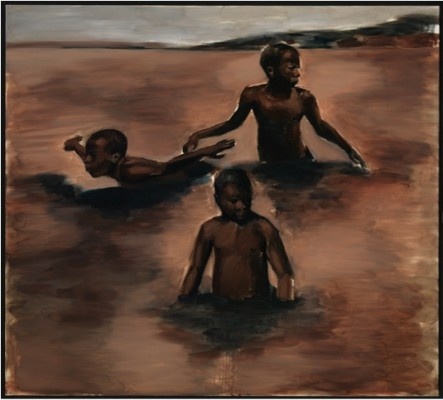
Consider the boy on the left, stretching out his arms in a soaring dive, skimming his breastbone across the top of the water, his eyes closed as if in fantasy becoming a bird. Is this the superhuman the artist spoke of wanting to create? The boy, transcending the discriminations of science, leaving the over-determined geographies of the land behind, has waded into the shifting light and colour of the sea, where he uses his body to simulate the non-human world; this transformation is not a denial of the world, but the realisation that social life offers everything we could want: fantasy without escapism, singularity without privacy, solitude without loneliness, freedom without violence. Everything is in shallow waters.
At this point the thought of these paintings as ‘historicism’ falls away; their technique causes the concept of ideology or system of representation to seem radically unstable. The following lines from J.H. Prynne’s poem Marzipan (1986) offer an understanding of how the gracefulness of leisure pursuits may be mined for underlying violence and desire of political life.
The same again not held back, to ask grace
at a graceless face it is our own
in the glass of dark recall, seen
at love all in the replay; the heartland
is dug out for a life underneath.
The painting may act as a ‘glass of dark recall’, somewhere we find our selves – in their most social or solipsistic aspects – not as static images but as surfaces in constant motion, and depths where we find traces of the performance of the painter’s body. Marzipan seems to describe a certain form of human endeavour in which an object (for these purposes, the work of art) is seen as a mirror for life, as if mirrors were a good place to look for answers about ourselves. These few lines offer an image of perfect similitude, a tennis court divided into two halves, whose players, of exactly equal ability, are labouring fruitlessly at a game, already a ‘replay’, which returns, infinitely, to ‘love all’ (which might, ultimately, mean no love at all). Here the same becomes a hall of mirrors in which the self can find nothing, but cannot stop looking. The last two lines illustrate this futility with the paradox of anatomical science: carving up a body in search of life. This stupidity has its corollary in an approach to a work of art: we can say where and when this painter was born, educated and paid, but these sociological facts are not sufficient to any understanding of the work. There is another body: the body-double the painter’s performance has made in paint, and this corresponds to another stupidity, a form of knowledge limited to the object in your field of vision, whose focus allows us to look at paintings without being able to say – in that moment – precisely what they are but experience them as the trace or partial presence of another and, in doing so, illuminate life without tearing the heart from the body.
These paintings, which are not portraits of persons but portraits of society, appear to militate against the culture of individualism enshrined at the national galleries of the Western world. In this sense Okwui Enwezor has called them ‘para-portraits’, but we cannot forget that a concept of life outside the art space is not denied. In fact, the poetics of their titles, refusing the viewer all the facts needed to establish a narrative, mean these pictures demand to be read as images of bodies. Take as an example the painting ‘Milk for the Maestro’ (2012). Two men face one another, standing so close to each other that it would be socially inadmissable for them not to be engaged in some activity together. They appear to be dancing. We do not know the identity of the Maestro for whom the milk is designated, and Google offers no intelligible answer to this phrase. A politician’s mastery of the concept of normality has often been measured by knowing the cost of milk. In 2007 Rudy Giuliani was humiliated on the campaign trail for underestimating the price by fifty percent. Long before that, Margaret Thatcher earned the nickname ‘Milk Snatcher’ for abolishing free milk provisions for primary school children. But investigation into the politics of milk is not likely to satisfy the demands of this painting. It reminds me of Hassan Khan’s film Jewel, featured in the same New Museum exhibition as Yiadom-Boakye’s paintings. In that film, two men, similarly placed in relation to each other, dance solemnly to the beat of Khan’s shaabi, a fusion of traditional and modern rhythms. The film featured alongside Yiadom-Boakye’s work in the New Museum exhibition, in the same year that ‘Milk for the Maestro’ was made, but it is by no means certain that Khan’s work had any influence on the later painting. Despite this, what does dancing mean in relation to these works?
In 2011 political protests and occupations announced collective desires for the transformation of government in gestures which established a common understanding of bodies in Cairo and New York and London. Shaabi became the sound of the uprisings in the early, optimistic days when there was dancing in Tahrir Square; Hassan Khan’s images continue to find significance in relation to ongoing hopes for the Egyptian revolution. Karl Marx, in the introduction to his ‘Contribution to the Critique of Hegel’s Philosophy of Right’ (1843), described how the ideologies and systems of representation which freeze man in violent relation to man could be overcome only by a reorientation of bodies; ‘Religion is only the illusory sun about which man revolves as long as he does not revolve about himself.’ The dialectical thinking which Marx proposes will move between a critique of religion and an understanding of the ‘true need’ to which it responds and thereby dissolve the opposition between them; ‘these petrified social conditions must be made to dance by singing their own melody to them. The people must be taught to beterrified of itself, in order to give it courage.’ Dancing here has a satirical function and revolutionary potential, an expression of mass submission to a common need, the most intense negation of misery and a real form of social organisation, through which the people is able to realise its power.
In 2012, the year which produced Step Up! Dance Revolution 3D, it is reassuring to be reminded that dancing is not merely the product of tired myths about personal liberation sold to excited and indifferent nations of millions: if art participates in the freezing of social relations between people, it can also work to unfreeze them. The violent gestural quality of Yiadom-Boakye’s painting, the playful disjuncture posed by the title, and the attitude it strikes towards a history of portrait painting means it dances before the viewer’s gaze, echoing Marx’s proposed reawakening, simultaneously celebratory and satirical, terrifying and courageous.
The two men in ‘Milk for the Maestro’ may not, ultimately, be dancing. It is unclear what the painting is meant to mean, but there is humility in the men’s shoelessness, dignity in their mutual gaze, elegance in the streaks of white across one man’s shirt, calm in the movement of these men, striking confidence in the painter’s brush, and it is possible to recognise in this dark image events at the synapses of bodies which this work witnesses but does not capture.
Yiadom-Boakye’s work, its research into the textures of darkness and deployment of rare particles of light, troubles the superficial whiteness of galleries and speaks beyond the gallery wall to the street, where the question – how we can live together in a peace which is not violent – remains unanswered.
